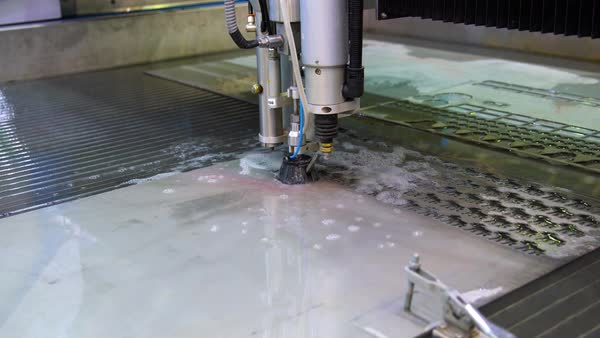Everyone thinks of CNC machining as a straightforward procedure that only happens with particular hardware able to create the parts you need for a product. While the definition still holds, CNC machining itself has evolved a great deal in the last 20 years. These days one of the most popular machining procedures is abrasive jet cutting, also known as water jetting. If the name sounds peculiar, it’s because the manufacturing procedure itself is as unique.
Water jetting is CNC machining done with water using engineering related to the application of pressure to power a power pump. The pump contains a mixture of water and certain abrasive substances that can mold, shape, and fabricate specific parts. The technique is also great for creating certain flat cut parts. The high-pressure pump can push water through the channels of the device using a nozzle that can handle 900ml a second. The substances contained in the water are usually granulated metals such as garnet or aluminum.

cnc water jetting machines*
The easiest way to explain jetting works is by going through the effect of the high-pressure pump in the materials it’s used with. The water circle is pretty intense at short range, enough to cut certain semi-soft materials such as foam, plastics, wood, and light metals. The water jets usually work with all variations of the device. You can treat materials with pure cycles, abrasion, percussion, cavitation, and hybrid settings. This manufacturing procedure is probably the best fit for materials that are easily affected by intense heat.
As surprising as it seems, there is also a great deal of room for precision with this technology. Lasers and plasma surely get the job done, but they are best suited for hardened metals or blocks of material that need a lot of work. Water jets, however, are one of the best methods to work surface carvings, especially in surfaces made of aluminum. The application of technology is not only for a specialized niche market. Manufacturers often use this technology to blank materials as well as flat panels in enclosures, brackets, and the chassis of some products.
Other Uses of Water Jetting
We have already mentioned a few common uses of water jetting, but more can be done with the technique. A proper manufacturer can handle enclosures such as panels, cases, boxes, rack mounts, consoles, and many more. Water jetting is also great for handling curved shapes and straight angles. The manufacturing of the chassis can be processed using hand-held jets, but long production cycles in industrial settings call for better hardware and computer software. Water jetting is held in high regard by many CNC operators because it offers a great deal of accuracy to the original model, and it takes away a lot of the issues created with chipping with light materials.
Some of the most popular industries using CNC water jetting are mining, automotive, robotics, electronics, and a large number of industrial workshops that need parts created using this technique. Water jetting is also one of the most common methods used to create certain engravements that can only be achieved using computer programs and the precise hand of an artisan. Water jetting is excellent to handle all grades of aluminum, copper, delrin, stainless steel, pure still as well as a large selection of plastic resins. Most metals are finished using bead blasting, or by anodizing them. Other quality finishes are achieved by plating, coating, or painting.
How Can I Know If Water Jetting is the Right Choice for My Project?
There is a lot to take in before choosing a manufacturing procedure. Water jetting is impressive, but it’s not exactly mainstream because it doesn’t have the same range as traditional CNC machining. However, you accomplish a lot of things with water jetting, such as cutting metals without having to deal with temperature issues. Since water is used, there is no heat-affected zone whatsoever, thus reducing the range of warpage. You won’t see the inner structure of the part compromised either because the rest of the surface of the material won’t be affected.
The main code used for water jetting tasks is the one that carries over the nozzle exactly where you need it to get things done. The water stream will hold steadily until the job is finished, and you’ll get some of the sharpest cuts you can get with the abrasive solution. Water jetting is also great for small parts, but edges tend to be a little trickier since you will have to use a tapper for some materials. As for the finished result of the job, water jetting will get you some of the cleanest products you can get with any CNC machining procedure. Done with lesser risks and exceptional detail, water jetting is also one of the most eco-friendly methods of manufacturing since the water solution can be reused quite a few times.
Reference
*Image from https://dissolve.com/
